remove seats MAZDA MODEL CX-9 2022 Owners Manual
[x] Cancel search | Manufacturer: MAZDA, Model Year: 2022, Model line: MODEL CX-9, Model: MAZDA MODEL CX-9 2022Pages: 715, PDF Size: 81.06 MB
Page 15 of 715

Seat Precautions
WA R N I N G
Make sure the adjustable components of a seat are locked in place:
Adjustable seats and seatbacks that are not securely locked are dangerous. In a sudden stop
or collision, the seat or seatback could move, causing injury. Make sure the adjustable
components of the seat are locked in place by attempting to slide the seat forward and
backward and rocking the seatback.
Never allow children to adjust a seat:
Allowing children to adjust a seat is dangerous as it could result in serious injury if a child's
hands or feet become caught in the seat.
Do not drive with the seatback unlocked:
All of the seatbacks play an important role in your protection in a vehicle. Leaving the
seatback unlocked is dangerous as it can a llow passengers to be ejected or thrown around
and baggage to strike occupants in a sudden stop or collision, resulting in severe injury. After
adjusting the seatback at any time, even when there are no other passengers, rock the
seatback to make sure it is locked in place.
Adjust a seat only when the vehicle is stopped:
If the seat is adjusted while the vehicle is being driven, the seating posture may become
unstable and the seat could move unexpectedly resulting in injury.
Do not modify or replace the front seats:
Modifying or replacing the front seats such as replacing the upholstery or loosening any bolts
is dangerous. The front seats contain air bag components essential to the supplemental
restraint system. Such modifications could damage the supplemental restraint system and
result in serious injury. Consult an Authorized Mazda Dealer if there is any need to remove or
reinstall the front seats.
Do not drive with damaged front seats:
Driving with damaged front seats, such as se at cushions torn or damaged down to the
urethane, is dangerous. A collision, even one no t strong enough to inflate the air bags, could
damage the front seats which contain essential air bag components. If there was a
subsequent collision, an air bag may not deploy which could lead to injuries. Always have an
Authorized Mazda Dealer inspect the front seats, front seat belt pretensioners and air bags
after a collision.
Essential Safety Equipment
Seats
2-2
CX-9_8KH5-EA-21K_Edition2_old 2021-9-16 14:11:22
Page 31 of 715
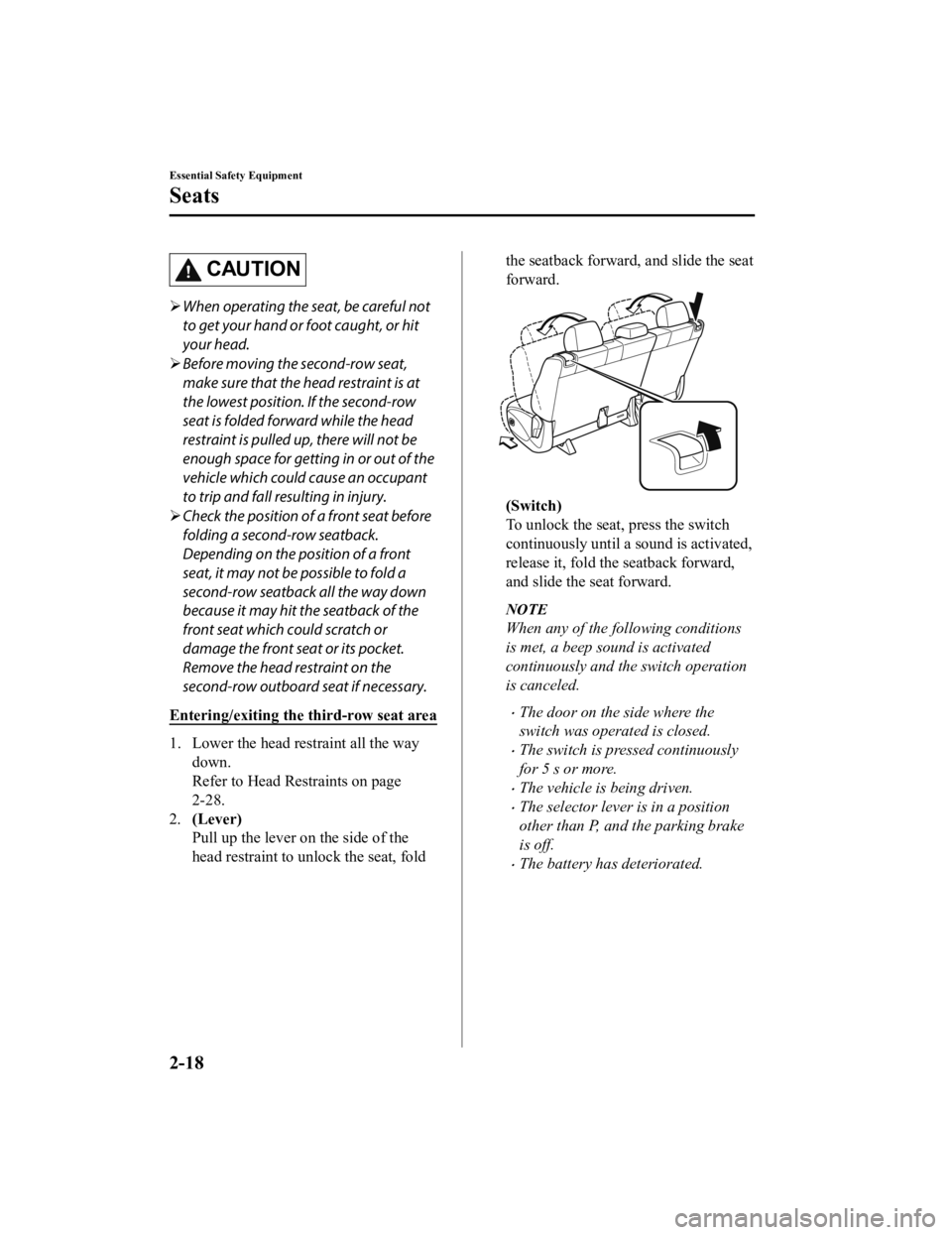
CAUTION
When operating the seat, be careful not
to get your hand or foot caught, or hit
your head.
Before moving the second-row seat,
make sure that the head restraint is at
the lowest position. If the second-row
seat is folded forward while the head
restraint is pulled up, there will not be
enough space for getting in or out of the
vehicle which could cause an occupant
to trip and fall resulting in injury.
Check the position of a front seat before
folding a second-row seatback.
Depending on the position of a front
seat, it may not be possible to fold a
second-row seatback all the way down
because it may hit the seatback of the
front seat which could scratch or
damage the front seat or its pocket.
Remove the head restraint on the
second-row outboard seat if necessary.
Entering/exiting the third-row seat area
1. Lower the head restraint all the way down.
Refer to Head Restraints on page
2-28.
2. (Lever)
Pull up the lever o n the side of the
head restraint to un lock the seat, fold
the seatback forward, and slide the seat
forward.
(Switch)
To unlock the seat, press the switch
continuously until a sound is activated,
release it, fold the seatback forward,
and slide the seat forward.
NOTE
When any of the following conditions
is met, a beep sound is activated
continuously and the switch operation
is canceled.
The door on the side where the
switch was operated is closed.
The switch is pressed continuously
for 5 s or more.
The vehicle is being driven.
The selector lever is in a position
other than P, and the parking brake
is off.
The battery has deteriorated.
Essential Safety Equipment
Seats
2-18
CX-9_8KH5-EA-21K_Edition2_old 2021-9-16 14:11:22
Page 33 of 715

There is a system problem.
CAUTION
After entering/exiting the third-row seat
area, lock the seat after sliding it rearward.
Make sure it is locked by attempting to
lightly move it back and forth.
Otherwise, it could move unexpectedly and
cause injury.
Second-row seat
fixed position Third-row seat
in
gress/egress
NOTE
The second-row seat cannot be moved
forward while the seat belt is securing the
child-restraint system.
After getting in or out of the vehicle
Move the seatback rearward, slide the seat
rearward, and lock the seat.
▼
Split folding the
Second-row Seats
To create a flat luggage compartment
space, fold the seatbacks forward.
Folding the seatbacks
WA R N I N G
Make sure the adjustable components of a
second-row seat are locked after folding
down the seatback:
A second-row seat that is not securely
locked is dangerous. In a sudden stop or
collision, the second-row seat could move,
causing injury.
After folding down the seatback of a
second-row seat, make sure the adjustable
components of the seat are locked in place
by attempting to slide the seat forward and
backward.
CAUTION
When folding the seatback forward,
always support the seatback with your
hand. If it is not supported by a hand,
fingers or the hand raising the lever
could be injured.
Check the position of a front seat before
folding a second-row seatback.
Depending on the position of a front
seat, it may not be possible to fold a
second-row seatback all the way down
because it may hit the seatback of the
front seat which could scratch or
damage the front seat or its pocket.
Remove the head restraint on the
second-row outboard seat if necessary.
Essential Safety Equipment
Seats
2-20
CX-9_8KH5-EA-21K_Edition2_old 2021-9-16 14:11:22
Page 38 of 715
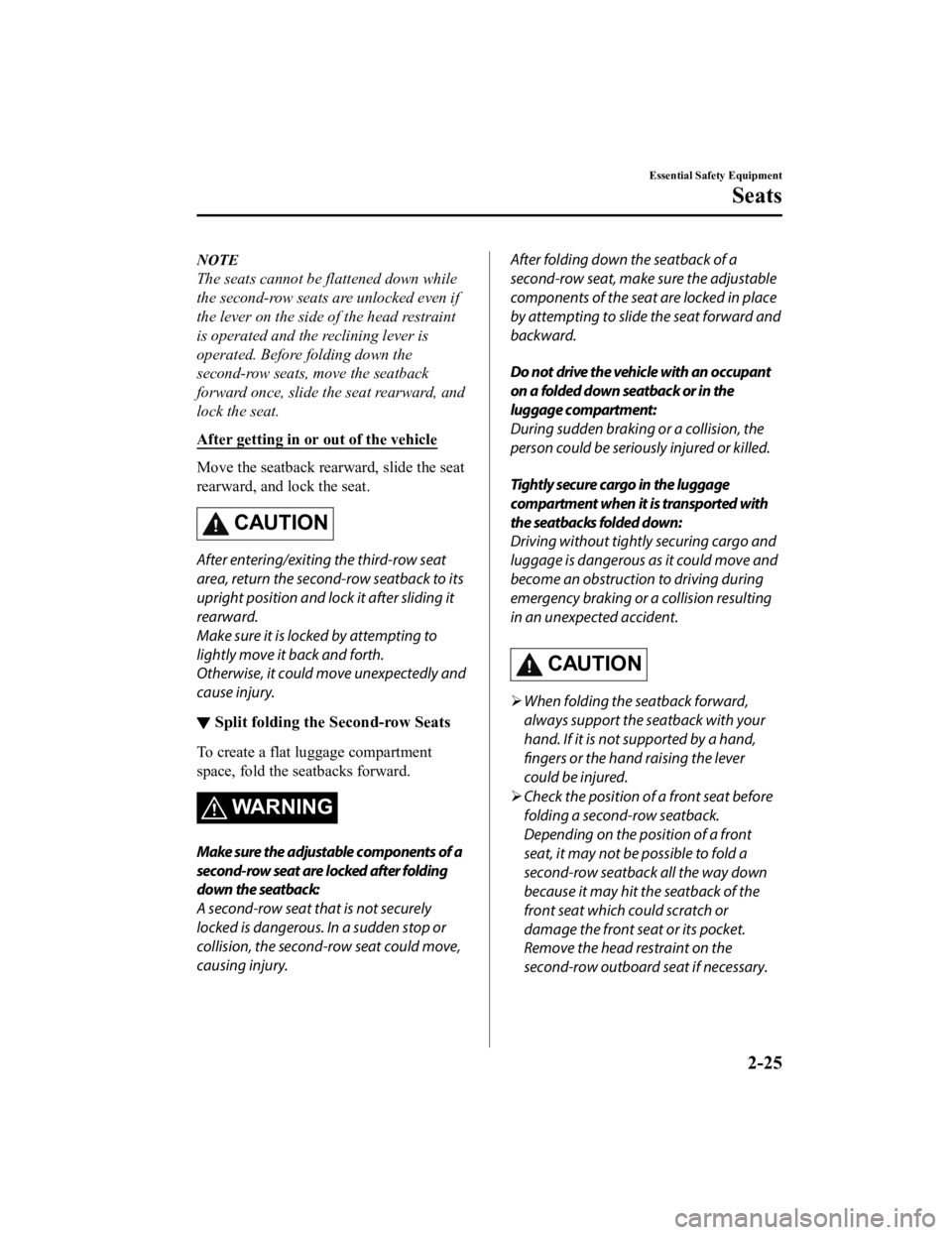
NOTE
The seats cannot be flattened down while
the second-row seats are unlocked even if
the lever on the side of the head restraint
is operated and the reclining lever is
operated. Before folding down the
second-row seats, move the seatback
forward once, slide the seat rearward, and
lock the seat.
After getting in or out of the vehicle
Move the seatback rearward, slide the seat
rearward, and lock the seat.
CAUTION
After entering/exiting the third-row seat
area, return the second-row seatback to its
upright position and lock it after sliding it
rearward.
Make sure it is locked by attempting to
lightly move it back and forth.
Otherwise, it could move unexpectedly and
cause injury.
▼ Split folding the Second-row Seats
To create a flat lu
ggage compartment
space, fold the seatbacks forward.
WARNING
Make sure the adjustable components of a
second-row seat are locked after folding
down the seatback:
A second-row seat that is not securely
locked is dangerous. In a sudden stop or
collision, the second-r ow seat could move,
causing injury.
After folding down the seatback of a
second-row seat, make sure the adjustable
components of the seat are locked in place
by attempting to slide the seat forward and
backward.
Do not drive the vehicle with an occupant
on a folded down seatback or in the
luggage compartment:
During sudden braking or a collision, the
person could be seriou sly injured or killed.
Tightly secure cargo in the luggage
compartment when it is transported with
the seatbacks folded down:
Driving without tightly securing cargo and
luggage is dangerous as it could move and
become an obstruction to driving during
emergency braking or a collision resulting
in an unexpected accident.
CAUTION
When folding the seatback forward,
always support the seatback with your
hand. If it is not supported by a hand,
fingers or the hand raising the lever
could be injured.
Check the position of a front seat before
folding a second-row seatback.
Depending on the position of a front
seat, it may not be possible to fold a
second-row seatback all the way down
because it may hit the seatback of the
front seat which could scratch or
damage the front seat or its pocket.
Remove the head restraint on the
second-row outboard seat if necessary.
Essential Safety Equipment
Seats
2-25
CX-9_8KH5-EA-21K_Edition2_old 2021-9-16 14:11:22
Page 41 of 715

Head Restraints
Your vehicle is equipped with head
restraints on all outboard seats and the
second-row center seat. The head
restraints are intended to help protect you
and the passengers from neck injury.
WA R N I N G
Always drive with the head restraints
installed when seats are being used and
make sure they are properly adjusted. In
addition, always raise the head restraints
on all second-row seats when they are
being used:
Driving with the head restraints adjusted
too low or removed is dangerous. With no
support behind your head, your neck could
be seriously injured in a collision.
NOTE
(Third-row seat)
The head restraints are non-adjustable.
▼ Height Adjustment
Adjust the head restra
int so that the center
is even with the top of the passenger's
ears.
To raise a head restraint, pull it up to the
desired position.
To lower the head restraint, press the
stop-catch release, then push the head
restraint down.
Front outboard seat
Second-row outboard seat
(6:4 Split Adjustable-type Bench Seat
Ty p e )
(Captain Seat Type)
Essential Safety Equipment
Seats
2-28
CX-9_8KH5-EA-21K_Edition2_old 2021-9-16 14:11:22
Page 42 of 715
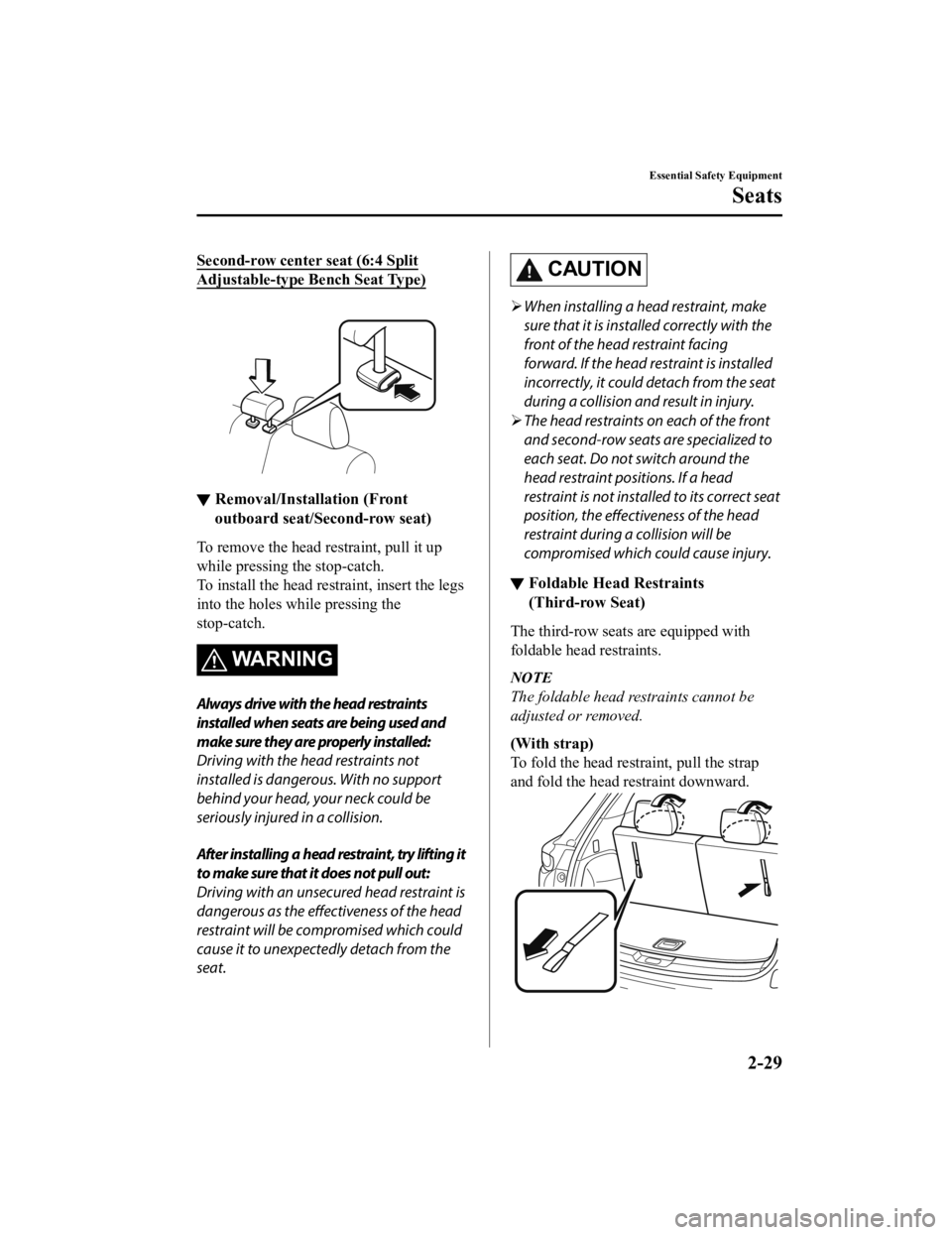
Second-row center seat (6:4 Split
Adjustable-type Bench Seat Type)
▼Removal/Installation (Front
outboard seat/Second-row seat)
To remove the head r
estraint, pull it up
while pressing the stop-catch.
To install the head restraint, insert the legs
into the holes while pressing the
stop-catch.
WARNING
Always drive with the head restraints
installed when seats are being used and
make sure they are properly installed:
Driving with the head restraints not
installed is dangerous. With no support
behind your head, your neck could be
seriously injured in a collision.
After installing a head restraint, try lifting it
to make sure that it does not pull out:
Driving with an unsecured head restraint is
dangerous as the effectiveness of the head
restraint will be compromised which could
cause it to unexpectedly detach from the
seat.
CAUTION
When installing a head restraint, make
sure that it is installed correctly with the
front of the head restraint facing
forward. If the head restraint is installed
incorrectly, it could detach from the seat
during a collision and result in injury.
The head restraints on each of the front
and second-row seats are specialized to
each seat. Do not switch around the
head restraint positions. If a head
restraint is not installed to its correct seat
position, the
effectiveness of the head
restraint during a collision will be
compromised which could cause injury.
▼ Foldable Head Restraints
(Third-row Seat)
The third-row seats are equipped with
foldable head restraints.
NOTE
The foldable head restraints cannot be
adjusted or removed.
(With strap)
To fold the head restraint, pull the strap
and fold the head restraint downward.
Essential Safety Equipment
Seats
2-29
CX-9_8KH5-EA-21K_Edition2_old
2021-9-16 14:11:22
Page 48 of 715
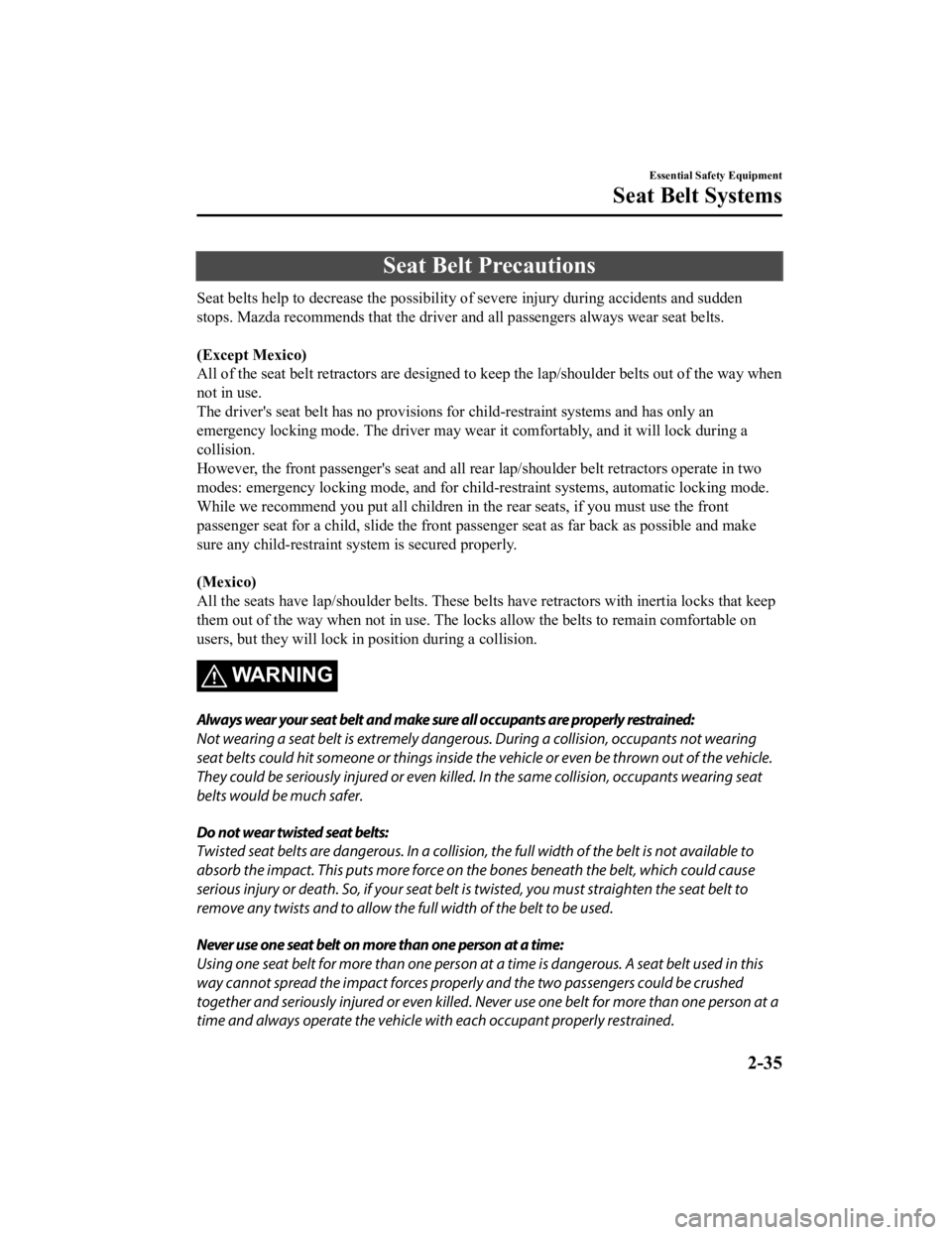
Seat Belt Precautions
Seat belts help to decrease the possibility of severe injury during accidents and sudden
stops. Mazda recommends that the driver and all passengers alwa ys wear seat belts.
(Except Mexico)
All of the seat belt retractors are designed to keep the lap/sh oulder belts out of the way when
not in use.
The driver's seat belt has no pr ovisions for child-restraint systems and has only an
emergency locking mode. The driver may wear it comfortably, and it will lock during a
collision.
However, the front passenger's s eat and all rear lap/shoulder belt retractors operate in two
modes: emergency locking mode, and for child-restraint systems, automatic locking mode.
While we recommend you put all children in the rear seats, if y ou must use the front
passenger seat for a child, slide the front passenger seat as f ar back as possible and make
sure any child-restraint sy stem is secured properly.
(Mexico)
All the seats have lap/shoulder belts. These belts have retract ors with inertia locks that keep
them out of the way when not in use. The locks allow the belts to remain comfortable on
users, but they will lock in position during a collision.
WARNING
Always wear your seat belt and make sure all occupants are properly restrained:
Not wearing a seat belt is extremely dangerou s. During a collision, occupants not wearing
seat belts could hit someone or things inside the vehicle or even be thrown out of the vehicle.
They could be seriously injured or even killed. In the same collision, occupants wearing seat
belts would be much safer.
Do not wear twisted seat belts:
Twisted seat belts are dangerous. In a collision, the full width of the belt is not available to
absorb the impact. This puts more force on the bones beneath the belt, which could cause
serious injury or death. So, if your seat belt is twisted, you must straighten the seat belt to
remove any twists and to allow the full width of the belt to be used.
Never use one seat belt on more than one person at a time:
Using one seat belt for more than one person at a time is dangerous. A seat belt used in this
way cannot spread the impact forces properly and the two passengers could be crushed
together and seriously injured or even killed. Ne ver use one belt for more than one person at a
time and always operate the vehicle wi th each occupant properly restrained.
Essential Safety Equipment
Seat Belt Systems
2-35
CX-9_8KH5-EA-21K_Edition2_old 2021-9-16 14:11:22
Page 68 of 715
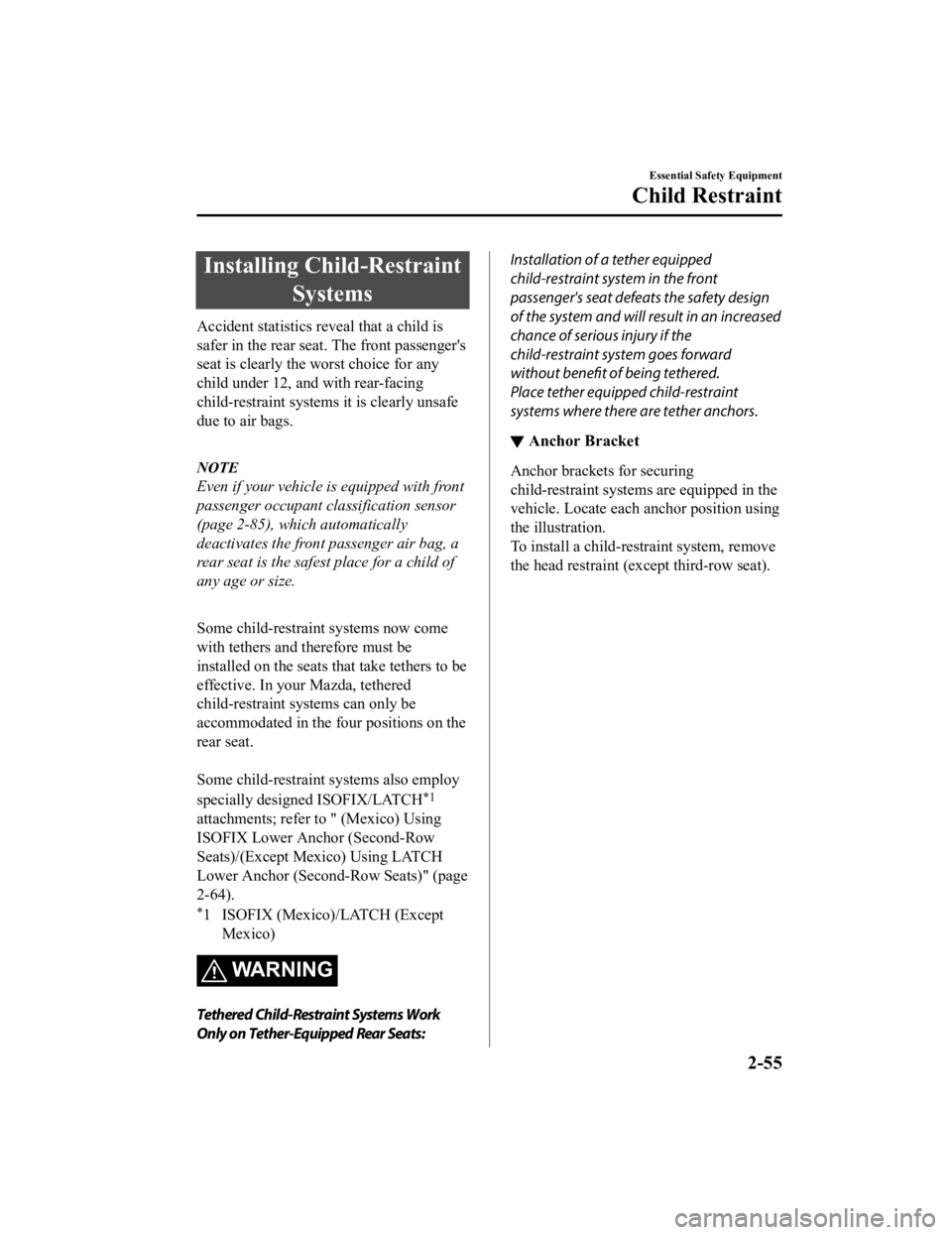
Installing Child-RestraintSystems
Accident statistics reveal that a child is
safer in the rear seat . The front passenger's
seat is clearly the worst choice for any
child under 12, and with rear-facing
child-restraint systems it is clearly unsafe
due to air bags.
NOTE
Even if your vehicle is equipped with front
passenger occupant classification sensor
(page 2-85), which automatically
deactivates the front passenger air bag, a
rear seat is the safest place for a child of
any age or size.
Some child-restraint systems now come
with tethers and therefore must be
installed on the seats that take tethers to be
effective. In your Mazda, tethered
child-restraint systems can only be
accommodated in the four positions on the
rear seat.
Some child-restraint systems also employ
specially designed ISOFIX/LATCH
*1
attachments; refer to " (Mexico) Using
ISOFIX Lower Anchor (Second-Row
Seats)/(Except Mexico) Using LATCH
Lower Anchor (Second-Row Seats)" (page
2-64).
*1 ISOFIX (Mexico)/LATCH (Except
Mexico)
WARNING
Tethered Child-Restraint Systems Work
Only on Tether-Equipped Rear Seats:
Installation of a tether equipped
child-restraint system in the front
passenger's seat defeats the safety design
of the system and will result in an increased
chance of serious injury if the
child-restraint system goes forward
without benefit of being tethered.
Place tether equipped child-restraint
systems where there are tether anchors.
▼Anchor Bracket
Anchor brackets for securing
child-restraint systems are equipped in the
vehicle. Locate each anchor position using
the illustration.
To install a child-restraint system, remove
the head restraint (except third-row seat).
Essential Safety Equipment
Child Restraint
2-55
CX-9_8KH5-EA-21K_Edition2_old
2021-9-16 14:11:22
Page 74 of 715

Do not allow a child or anyone to lean over
to or against the side window of a vehicle
with side and curtain air bags:
It is dangerous to allow anyone to lean
over to or against the side window, the
area of the front passenger seat, the front
and rear window pillars and the roof edge
along both sides from which the side and
curtain air bags deploy, even if a
child-restraint system is used. The impact
of inflation from a side or curtain air bag
could cause serious injury or death to an
out of position child. Furthermore, leaning
over to or against the door could block the
side and curtain air bags and eliminate the
advantages of supplemental protection.
Because the front seats are equipped with
front air bags, the rear seat is always a
better location for children. Take special
care not to allow a child to lean over to or
against the side window, even if the child is
seated in a child-restraint system.
Always remove the head restraint and
install child-restraint system (except when
installing a backless booster seat):
Installing a child-restraint system without
removing the head restraint is dangerous.
The child-restraint system cannot be
installed correctly which may result in
death or injury to the child in a collision.
Always install the head restraint and adjust
it to the appropriate position after
removing the child-restraint system:
Driving with the head restraint removed is
dangerous as impact to the occupant's
head cannot be prevented during
emergency braking or in a collision, which
could result in a serious accident, injury or
death.
Refer to Head Restraints on page 2-28.Front Passenger's Seat Child-Restraint
System Installation (With Front
Passenger Occupant Classification
System)
1. Make sure the ignition is switched off.
2. Slide the seat as far back as possible.
3. Remove the head restraint. However,
when installing a backless booster seat,
always install the vehicle head restraint
to the seat where the backless booster
seat is installed.
4. Place the child-restraint system on the seat without putting your weight on the
seat and fasten the seat belt. See the
manufacturer's instructions on the
child-restraint system for belt routing
instructions.
5. To get the retractor into the automatic
locking mode, pull the shoulder belt
portion of the seat belt until the entire
length of the belt is out of the retractor.
6. Push the child-restraint system firmly into the vehicle seat. Be sure the belt
retracts as snugly as possible. A
clicking noise from the retractor will
be heard during retraction if the system
is in automatic lo cking mode. If the
belt does not lock the seat down tight,
repeat the previous step and also this
one.
Essential Safety Equipment
Child Restraint
2-61
CX-9_8KH5-EA-21K_Edition2_old 2021-9-16 14:11:22
Page 77 of 715
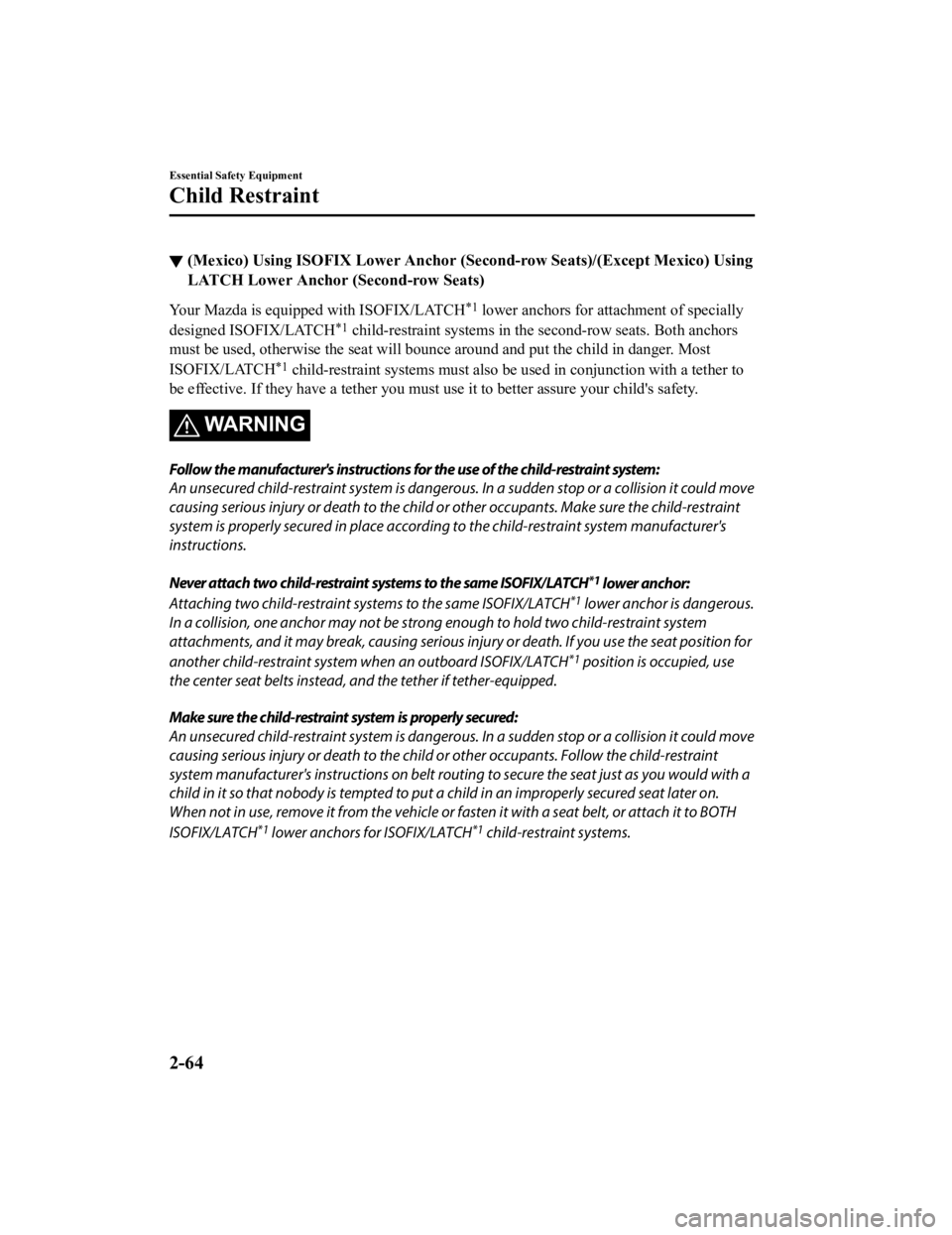
▼(Mexico) Using ISOFIX Lower Anchor (Second-row Seats)/(Except M
exico) Using
LATCH Lower Anchor ( Second-row Seats)
Your Mazda is equipped with ISOFIX/LATCH*1 lower anchors for attachment of specially
designed ISOFIX/LATCH
*1 child-restraint systems in the second-row seats. Both anchors
must be used, otherwise the seat will bounce around and put the child in danger. Most
ISOFIX/LATCH
*1 child-restraint systems must also be used in conjunction with a tether to
be effective. If they have a tether you must use it to better assure your child's safety.
WA R N I N G
Follow the manufacturer's instructions for the use of the child-restraint system:
An unsecured child-restraint system is dangerous. In a sudden stop or a collision it could move
causing serious injury or death to the child or other occupants. Make sure the child-restraint
system is properly secured in place according to the child-restraint system manufacturer's
instructions.
Never attach two child-restraint systems to the same ISOFIX/LATCH
*1 lower anchor:
Attaching two child-restraint systems to the same ISOFIX/LATCH
*1 lower anchor is dangerous.
In a collision, one anchor may not be strong enough to hold two child-restraint system
attachments, and it may break, causing serious inju ry or death. If you use the seat position for
another child-restraint system when an outboard ISOFIX/LATCH
*1 position is occupied, use
the center seat belts instead, and the tether if tether-equipped.
Make sure the child-restraint system is properly secured:
An unsecured child-restraint system is dangerous. In a sudden stop or a collision it could move
causing serious injury or death to the child or other occupants. Follow the child-restraint
system manufacturer's instructions on belt routing to secure the seat just as you would with a
child in it so that nobody is tempted to put a child in an improperly secured seat later on.
When not in use, remove it from the vehicle or fa sten it with a seat belt, or attach it to BOTH
ISOFIX/LATCH
*1 lower anchors for ISOFIX/LATCH*1 child-restraint systems.
Essential Safety Equipment
Child Restraint
2-64
CX-9_8KH5-EA-21K_Edition2_old 2021-9-16 14:11:22